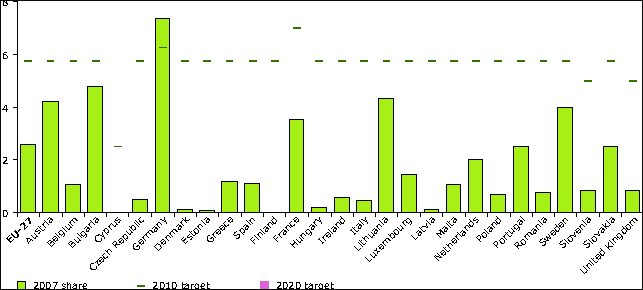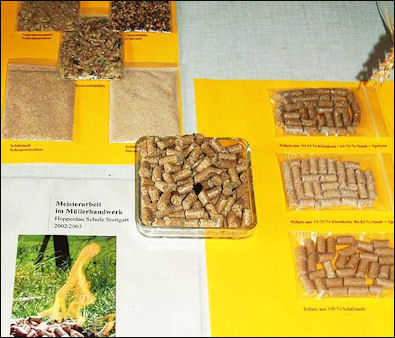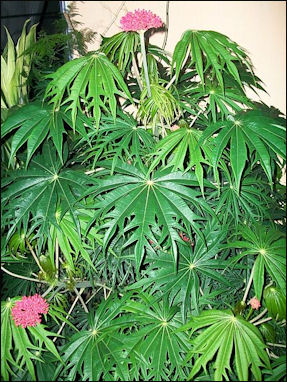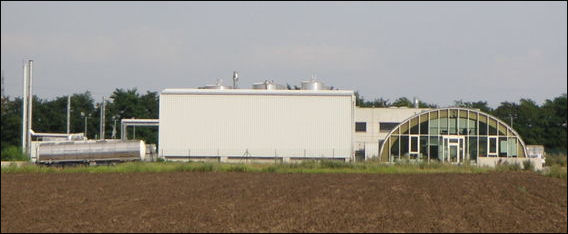BIOFUEL
biofuel-powered bus Many people feel that one answer to the world’s energy shortage is to use more is biofuel. Biofuels include ethanol made from crops like sugars or grains and biodiesel made from vegetable oil or animal fats. Ethanol is a form of alcohol that can be made from rapeseed, sugar cane, palm oil or other organic materials. Both ethanol and biodiesel can be blended with existing fuels or used as fuels in their own right. Using them reduces our reliance on fossil fuels and cuts vehicular pollution.
In the United States bioethanol, which can be mixed with gasoline, is the favored fuel. In Europe, where there are many diesel powered vehicles, biodiesel is the fuel of choice. Ethanol delivers about 30 percent less energy than gasoline but is about 20 percent cheaper.
The biofuel market in 2010 was valued at around $100 billion. Ethanol made mostly from sugar cane is widely used in Brazil. Many developed countries are subsidizing home grown biofuel sources while blocking cheaper Brazilian ethanol, which is far less damaging to global food security. Shell is the largest seller of biofuels. The main beneficiary of biofuel sales are farmers and agribusiness that profit from higher prices of grains and other sources used to make biofuels.
Some people initially trumpeted biofuel as a kind of energy panacea because unlike fossil fuels they are renewable. You can produce a new supply every year or even twice a year. A major push to develop biofuels came countries in the European Union set a target of getting 5.75 percent of their transportation fuel form renewable sources such as biofuel by 2010 and 10 percent by 2020. To boost production of biofuels European governments offered tax breaks, subsidies for farmers and funding for research. In 2007, U.S. President George Bush called for a massive increase in the use of biofuels in the United States. That year farmers planted 36.6 million hectares of corn, the most since World War II and 17 percent more than the previous year.
The main sources for biofuel at this time are palm oil, rapeseed (colza), sunflowers, sugar cane, corn, and jatropha. Palm oil is the cheapest vegetable oil. It is produced mainly in Indonesia and Malaysia on land formally covered by tropical rainforests. New processes that can turn woody, weedy plants like switch grass, poplar, wheat straw and corn stalks into cellulosic ethanol.
Problems with Biofuel

jet engine running on biofuelA closer look at biofuels has revealed a number of problems.The main drawback with biofuels is that if they are to be considered a serious alternative to gasoline large amounts of agricultural land will have to be devoted to raising crops for them. It is estimated that for Europe to meet 10 percent of its road transport energy needs with biofuels would require it to use 70 percent of its current cropland. That could lead to food shortages and higher food prices. In the developing world there are worries that the raising of crops for biofuels could lead to more deforestation and the use of precious land to grow crops for fuels rather than food for hungry people.
The amount of corn needed to make enough biofuel to fill one SUV tank could can feed one person for an entire year. Even though the United States is the world’s largest producer of soy beans and corn if 100 percent of both crops were used to make biofuel they would only reduce road fuel consumption by 11 percent.
To come up with enough land to produces enough biofuel to make a significant reduction in the amount oil used would require destroying more forests and grasslands which in the end would create more carbon dioxide than it would get rid of. According to an Oxfam report, “Biofuels are taking over agricultural land and forcing farming to expand into lands that are important carbon sinks, like forests and wetlands. This triggers the release of carbon from soil and vegetation that will take decades to repay.” Oxfam and other aid and environmental groups have called for the European Union to scrap its target of getting 10 percent of its transportation fuel from renewable sources such as biofuel by 2020.
A 2010 study by the European Commission determined that using fossil fuels in vehicles was better for the environment than biofuels because of the amount of the carbon released and environmental damage caused by burning down forest to increase agriculture land used to grow crops for biofuels. The conversion of rainforests to palm oil plantations is especially wasteful. By one calculation it takes 840 years for a palm oil plantation to soak up the carbon emitted by the rainforest burned down to make way for the plantation.
Biofuels and High Food Prices

Biofuel dispenser for several
ethanol and biodiesel blends
Shifting the production of crops to make biofuel rather than food has caused prices of some food stuffs to soar. When American farmers began switching from wheat to corn and soy beans to meet biofuel demands in the 2000s, corn prices tripled. The price of wheat went up as the supply was reduced. Prices for soy beans also soared as demand for it as a source of fuel rose. The ramifications were on a global scale: food riots in Mexico over corn price hikes, increased beer prices at Munich’s Oktoberfest and high soy prices in China and Japan. With soy prices so high palm oil became an attractive alternative.
In June 2008, Oxfam released a report that stated that biofuels were responsible for 30 percent of the increase in global food prices and this was responsible for plunging 30 million people into poverty. Britain’s chief science advisor John Beddington said, “It’s very hard to imagine how we can see the world growing enough crops to produce renewable energy and at the same time meet the enormous demand for food.” India’s finance minister called biofuels a “crime against humanity.” Stock prices for bioeful firms which soared in 2006 and 2007, crashed in 2008.
The use of crops and land for biofuel production of can have ripple effects. If the farmers in one area switch to corn because the price has gone up that means that the supply of the crops of the farmers grew before’say soy beans — goes down and its prices go up too, creating more demand and causing forests to be cleared to produces those crops too. Price hikes for corn and soy beans and other commodities related to increased demand were blamed for food riots in Pakistan, Haiti, Cameroon, Yemen, Ivory Coast and other places and malnutrition in Africa in the late 2000s.
Biofuel and Agricultural Land
The main drawback with biofuels is that if they are to be considered a serious alternative to gasoline large amounts of agricultural land will have to be devoted to raising crops for them. It is estimated that for Europe to meet 10 percent of its road transport energy needs with biofuels would require it to use 70 percent of its current cropland. That could lead to food shortages and higher food prices. In the developing world there are worries that the raising of crops for biofuels could lead to more deforestation and the use of precious land to grow crops for fuels rather than food for hungry people.
The amount of corn needed to make enough biofuel to fill one SUV tank could can feed one person for an entire year. Even though the United States is the world’s largest producer of soy beans and corn if 100 percent if both crops were used to make biofuel they would only reduce road fuel consumption by 11 percent.
There are also environmental aspects of the problem to consider. To come up with enough land to produces enough biofuel to make a significant reduction in the amount oil used would require destroying more forests and grasslands which in the end would create more carbon dioxide than it would get rid of. According to an Oxfam report, “Biofuels are taking over agricultural land and forcing farming to expand into lands that are important carbon sinks, like forests and wetlands. This triggers the release of carbon from soil and vegetation that will take decades to repay.” Oxfam and other aid and environmental groups have called for the European Union to scrap its target of getting 10 percent of its transportation fuel from renewable sources such as biofuel by 2020.

Biodiesel carbon emmissions
Biodiesel
Biodiesel can be made from soy beans, sunflowers, safflower or other crops. In Europe it is made mainly from canola and in the United States it is made mostly from soybeans. In Europe, biodiesel is blended at a rate of 5 percent with regular mineral diesel. Cars with diesel engines can run on ethanol as well as peanut oil, chicken fat, beef fat and oil used to cook French fries.
To make biodiesel, plant oils are chemically altered to make diesel, a process that uses less energy than distilling ethanol. The main drawbacks are low yields and high cost, about twice that of ethanol. In addition, biodiesel produces lots the pollutant nitrogen oxide and requires lots of energy in the form of fertilizer to grow the soy beans of other crops.
Soy-bean -based ethanol produces carbon dioxide but about 40 percent less than regular diesel. A diesel and kerosene substitute called biomass to liquids (BTL) shows promise as a potential new fuel.
Bioethanol
Bioethenal is usually made from corn, soy or sugar cane and is good for the environment in that it produces low levels of carbon dioxide. Sugar cane yields eight times more energy than corn and makes up 40 percent of all the fuel sold in Brazil.
Biofuel sources (gallons per acre): 1) sugar beets (714); 2) sugar cane (662); 3) cassava (410); 4) sorghum (374); 5) corn (354).
There are two main kinds of ethanol: 1) corn ethanol derived from corn, sugar cane and soy beans; and 2) cellulosic ethanol derived from plants like switchgrass (summer grass) , wood chips, agricultural wastes such as stalks and leaves and husks, forest waste such as bark and sawdust, paper pulp and timber chip. The latter produces more energy than corn ethanol but takes more energy to manufacture.

Biofuels in the EU
Corn Bioethanol
Corn is made into ethanol by grinding the corn, mixing it with water and heating it. Enzymes are added that convert starch to sugar. Fermentation turns the sugar into alcohol, which is separated from the water by distillation. Waste solids are fed to livestock. Wastewater can be made into fertilizer. The biggest drawback with the process — especially if coal energy is used to provide heat for distillation — is that it produces a lot of carbon dioxide.
In 2007, about 25 percent of the total corn crop of the United States was used for biofuel. The demand for corn for biofuels helped boost corn prices to a record high of $288.10 per ton in June 2008. Corn isn’t the best biofuel crop . It requires large amounts of herbicides and nitrogen fertilizer and can cause soil erosion. Producing it requires about as much energy as is produced by the fuel. Corn-based ethanol produces carbon dioxide but about 15 percent less than gasoline.
Sugar Bioethenal
Sugar is better than corn as a bioethenal source. It yields 600 to 800 gallons an acre, twice as much as corn. Sugar cane stalks are 20 percent sugar, negating the need for expensive enzymes to change starch to sugar, and they start to ferment almost as soon as they are cut. Waste cane can be burned to provide heat for distillation, reducing the burning of fossil fuels. Sugar-based ethanol produces 80 percent less carbon dioxide than gasoline.
One massive sugar cane refinery in Pradopolis, Brazil — one of the largest ethanol factories in the world — turns seven million tons of sugar cane into 300 million liters of ethanol each year. It is very efficient, using sugarcane waste, known as “bagasse”, for power and recycling wastewater for fertilizer. Using the sugar cane biomass for electricity and heat, the plant produces eight units of ethanol for every unit of fossil fuels it uses.
Grass and Tobacco as Biofuel Sources
The race is on to develop good celluloid sources of biofuel and processing technologies that have high energy yields. Cellulose sources are cheaper and more abundant than food crops but extracting the ethanol from cellulosic material is more difficult and expensive because the sugars necessary to make the fuel are bound in the cellulose materials — namely in a gluey binding material called lignin — and difficult to extract. To unlock the cellulose molecules from the lignin requires heat, acid and time. To break down the cellulose into sugars requires high tech acids and turning the resulting concoction into fuel requires fermentation in tanks with bacteria . The process is expensive and yields a fuel with just 45 percent of the energy content of the original biomass. In contrast refined oil has 85 percent of the energy of crude oil. The hope is that a better means of breaking down the cellulose can be found — perhaps from genetically-modified microbes or enzymes from the guts of termites.

biofuel pellets Elephant grass is being touted as one of the best biofuel sources. It can grow in abundance almost anywhere; needs no fertilizer; and is resistance to disease and pests. It produces large amounts of material that can be easily harvested using available technology and can be burned in any power station. Studies in Europe have showed that if it were grown on 10 percent of the suitable land there it could produce 9 percent of Europe’s energy needs. A close relative of sugar cane, elephant grass is a perennial that grows to four meters high and produces significantly more biomass than other plants and doesn’t deplete soil of nutrients. It needs sufficient water and power plants that can burn it. One hectare produces the energy equivalent of 36 barrels of oil. The yield for farmers is around $2,200 a hectare.
Japanese scientist at Gifu University have developed technology to make high quality bioethanol from grass and weeds. The technology shows promise because it can use materials such as grass cleared from fields and golf courses as its main material. To make ethanol from grass, 50-degree-C water is added to dried grass with some special enzymes that break down the grass, which ferments, in the process producing ethanol which is distilled pure from the mix. One ton of grass can produce 200 to 250 kilograms of ethanol.
Scientists are studying the possibility of using generically-modified tobacco to as a bioeful. The idea is being given serious thought because using tobacco does not affect food sources and it could provide income for tobacco farmers as smoking declines. Tobacco is an attractive “energy plant” because it generates a large amounts of oil and sugar more efficiently than other crops. Scientists have already figured out a way to bioengineer tobacco plants to produces as much as 20 percent more oil than they produce naturally.
Another area being explored is generating bioeful from waste material such as wood chips, agricultural waste and even garbage.
Algae as a Biofuel Source

Royal Dutch Shell is experimenting with growing marine algae as a biofuel source. The advantage with algae is that it grows fast, produces plentiful amounts of vegetable oil, produces more energy than other biofuels, and it can be grown in ponds of seawater, negating the need for fertile soils and fresh water. Algae can double its mass several times a day and produce more than 15 times more oil per hectare than grain crops. An environmental plus is that during the production stage algae consumes carbon dioxide rather than producing it.
The biggest problem with algae as a fuel source at this time is that extracting oil from the algae is much more expensive than extracting it from conventional biofuel sources. Another problem is finding the right algae. There are 40,000 known species. Some produce lots of oil but don’t grow very fast. Others grow fast but don’t produce much oil. Researchers at Arizona State University and Utah State University are each experimenting with about and 400 to 500 different kinds of algae and say “it’s a daunting task.” The team at Arizona State has been at work on the project since the 1970s.
ExxonMobile is collaborating with the biotechnology company Synthetic Genomics on an algae biofuel project. Scientists involved with the project are currently trying to find the right algae strain and then maximize its hydrocarbon production. Once those challenges are worked out it will take quite a bit of work to figure out how to produce algae-based fuels in sufficient quantities to make them worthwhile and transform the biofuels into fuels that can be put in cars, planes and boats. If the project shows promise ExxonMobile might invest more than $600 million in research and development.
Jatropha as a Biofuel Source
The jatropha, an ugly, fast-growing and poisonous weed, holds great promise as a biofuel source, especially for biodiesel. Native to Central America and the Caribbean, it was introduced to Europe and India in the 16th century by the Portuguese, who used oil from the seeds to light lamps. Jatropha bushes produce seeds that are up to 40 percent oil. The oil in turn can be used with relatively little processing in diesel-powered cars. Among those that are promoting jatropha are BP, Toyota and activist Bob Geldof.

Jatropha multifida Jatropha needs 600 millimeters of rain annually to thrive but can survive three consecutive years of drought by dropping its leaves. Growing well in alkaline soils and other poor soils and resistant to pests, it grows almost anywhere in tropical and subtropical climates. It even grows well in saline soils in very dry places with very little fertilizer. The bushes prevents erosion and enrich the soil with nutrients from its fallen leaves.
Jatropha is cheap and easy to cultivate. Seedlings cost around 10 cents a piece in places like Pakistan and India and yield seeds after one year of growth and oil after two years. A kilogram of seeds cost as little about 15 cents and a plant can live up to 50 years. The oil is producing by crushing the seeds. The residue can be used as biomass in electricity plants, generating four times as much energy per hectare as soy beans and ten times as much as corn.
Jatropha produces more oil per hectare than almost any other plant. One hectare of jatropha bushes produces 2.7 tons of oil and four tons of biomass. An 8,000-hectare plantations produces enough material to run a 1.5 megawatt station with enough power for 25,000 homes. The plant has only come in vogue recently as an energy sources. In the past it was mostly used as a wind break, form of live fencing and an ingredient for candles. Sometimes it has been prescribed as a malaria remedy and folk medicine even though its sap is a skin irritant and poison from three untreated seeds is enough to kill a person.
In December 2008, an Air New Zealand 747 was test flown using a 50-50 blend of jatropha-derived oil and conventional jet fuel. Similar tests have also been conducted in Japan and the United States. Virgin has used bioeful made from coconut oil and babassu nut oil. Continental has used a blend made from jatropha and algae while Japan Airlines has experimented with a fuel made from camelina oilseed.
BP and the British biofuel firm D-1 are raising jatropha on a 1,000-hectare plantation in Swaziland and plan to spend $160 million to expand the cultivation area to 1 million hectares.
Heat-loving bacteria from deep sea thermal vents also shows promise in helping to produce ethanol fuel.
Biomass
Biomass is the burning of wood chips, straw, waste wood and other materials to generate electricity. If a good supply of waste wood is available the technology works well but it doesn’t produce that much electricity. If forest trees are used the cost of hauling the trees to the plant can exceed the amount of energy produced.

biodiesel refinery
Image Sources: Wikimedia Commons
Text Sources: “The Private Life of Plants: A Natural History of Plant Behavior” by David Attenborough (Princeton University Press, 1997); National Geographic articles. Also the New York Times, Washington Post, Los Angeles Times, Smithsonian magazine, Natural History magazine, Discover magazine, Times of London, The New Yorker, Time, Newsweek, Reuters, AP, AFP, Lonely Planet Guides, Compton’s Encyclopedia and various books and other publications.
Last updated March 2011

